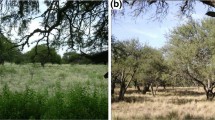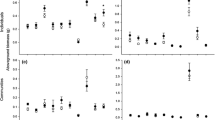Abstract
Within a plant community, variation among species in their abilities to exploit different types of soil patches can promote increased species diversity. However, it also has been suggested that some species may be disproportionately abundant along the edges between soil patches (i.e. soil microedges). We investigated the potential mechanisms whereby microedges can offer distinct ecological niches. Desmodium canadense, a tallgrass prairie species observed anecdotally to be abundant along patch edges, was grown in homogenized sandy loam (low-quality patch), clay loam (high-quality patch), or along the microedge between these two substrates, both in the presence or absence of competitors (Andropogon gerardii and Solidago juncea). Treatment effects on the biomass and root foraging strategies of D. canadense were assessed and compared to the responses of Andropogon gerardii and Solidago juncea. Although D. canadense biomass was highest in the clay loam without competition, with competition D. canadense biomass was highest along the microedge, which was a pattern not observed in A. gerardii or S. juncea. D. canadense also exhibited disproportionate root proliferation along the microedge into the clay loam patch, regardless of competitor presence. Although D. canadense biomass can be limited in both low- and high-quality soil patches, the edges between these patches allow D. canadense to avoid intense aboveground competition yet still access beneficial soil patches through lateral root foraging, thus enabling soil patch microedges to serve as a unique ecological niche.



Similar content being viewed by others
References
Abrahamson WG, Dobley KB, Houseknecht HR, Pecone CA (2005) Ecological divergence among five co-occurring species of old-field goldenrods. Plant Ecol 177:43–56. https://doi.org/10.1007/s11258-005-2069-2
Angers DA, Caron J (1998) Plant-induced changes in soil structure: processes and feedbacks. Biogeochemistry 42:55–72. https://doi.org/10.1023/A:1005944025343
Baer SG, Blair JM, Collins SL (2015) Environmental heterogeneity has a weak effect on diversity during community assembly in tallgrass prairie. Ecol Monogr 86:94–106. https://doi.org/10.1890/15-0888.1
Bátori Z, Erdős L, Kelemen A, Deák B, Valkó O, Gallé R, Bragina TM, Kiss PJ, Kröel-Dulay G, Tölgyesi C (2018) Diversity patterns in sandy forest-steppes: a comparative study from the western and central Palaearctic. Biodivers Conserv 27:1011–1030. https://doi.org/10.1007/s10531-017-1477-7
Birch CPD, Hutchings MJ (1994) Exploitation of patchily distributed soil resources by the clonal herb Glechoma hederacea. J Ecol 82:653–664. https://doi.org/10.2307/2261272
Brandt AJ, de Kroon H, Reynolds HL, Burns JH (2013) Soil heterogeneity generated by plant-soil feedbacks has implications for species recruitment and coexistence. J Ecol 101:277–286. https://doi.org/10.1111/1365-2745.12042
Burns JH, Brandt AJ, Murphy JE, Kaczowka AM, Burke DJ (2017) Spatial heterogeneity of plant-soil feedbacks increases per capita reproductive biomass of species at an establishment disadvantage. Oecologia 183:1077–1086. https://doi.org/10.1007/s00442-017-3828-1
Cahill JF, Casper BB (1999) Growth consequences of soil nutrient heterogeneity for two old-field herbs, Ambrosia artemisiifolia and Phytolacca americana, grown individually and in combination. Ann Bot 83:471–478. https://doi.org/10.1006/anbo.1999.0841
Cahill JF, McNickle GG (2011) The behavioral ecology of nutrient foraging by plants. Annu Rev Ecol Evol S 42:289–311
Cahill JF, McNickle GG, Haag JJ, Lamb EG, Nyanumba SM, Clair CCS (2010) Plants integrate information about nutrients and neighbors. Science 328:1657–1657
Campbell BD, Grime JP, Mackey JML (1991) A trade-off between scale and precision in resource foraging. Oecologia 87:532–538. https://doi.org/10.1007/BF00320417
Core Team R (2019) R: A language and environment for statistical computing. R Foundation for Statistical Computing, Vienna, Austria
Day KJ, Hutchings MJ, John EA (2003) The effects of spatial pattern of nutrient supply on yield, structure and mortality in plant populations. J Ecol 91:541–553. https://doi.org/10.1046/j.1365-2745.2003.00799.x
de Casenave JL, Pelotto JP, Protomastro J (1995) Edge-interior differences in vegetation structure and composition in a Chaco semi-arid forest, Argentina. Forest Ecol Manag 72:61–69. https://doi.org/10.1016/0378-1127(94)03444-2
Eldridge DJ, Whitford WG (2009) Badger (Taxidea taxus) disturbances increase soil heterogeneity in a degraded shrub-steppe ecosystem. J Arid Environ 73:66–73. https://doi.org/10.1016/j.jaridenv.2008.09.004
Erdős L, Krstonošić D, Kiss PJ, Bátori Z, Tölgyesi C, Škvorc Ž (2019) Plant composition and diversity at edges in a semi-natural forest–grassland mosaic. Plant Ecol 220:279–292. https://doi.org/10.1007/s11258-019-00913-4
Fitter AH (1982) Influence of soil heterogeneity on the coexistence of grassland species. J Ecol 70:139. https://doi.org/10.2307/2259869
Fransen B, de Kroon H, Berendse F (1998) Root morphological plasticity and nutrient acquisition of perennial grass species from habitats of different nutrient availability. Oecologia 115:351–358. https://doi.org/10.1007/s004420050527
Fransen B, Blijjenberg J, de Kroon H (1999) Root morphological and physiological plasticity of perennial grass species and the exploitation of spatial and temporal heterogeneous nutrient patches. Plant Soil 211:179–189
Fransen B, de Kroon H, Berendse F (2001) Soil nutrient heterogeneity alters competition between two perennial grass species. Ecology 82:2534–2546. https://doi.org/10.2307/2679934
Gibson DJ, Connolly J, Hartnett DC, Weidenhamer JD (1999) Designs for greenhouse studies of interactions between plants. J Ecol 87:1–16. https://doi.org/10.1046/j.1365-2745.1999.00321.x
Gosz JR (1993) Ecotone hierarchies. Ecol Appl 3:369–376. https://doi.org/10.2307/1941905
Gross K, Peters A, Pregitzer K (1993) Fine root growth and demographic responses to nutrient patches in four old-field plant species. Oecologia 95:61–64. https://doi.org/10.1007/BF00649507
Hennenberg KJ, Goetze D, Kouamé L, Orthmann B, Porembski S (2005) Border and ecotone detection by vegetation composition along forest-savanna transects in Ivory Coast. J Veg Sci 16:301–310. https://doi.org/10.1111/j.1654-1103.2005.tb02368.x
Henry J, Bruckerhoff S, Kaiser J (2006) USDA plant fact sheet: showy ticktrefoil. USDA Natural Resources Conservation Service. https://plants.usda.gov/factsheet/pdf/fs_deca7.pdf. Accessed 26 May 2018
Hodge A (2004) The plastic plant: root responses to heterogeneous supplies of nutrients. New Phytol 162:9–24. https://doi.org/10.1111/j.1469-8137.2004.01015.x
Honnay O, Verheyen K, Hermy M (2002) Permeability of ancient forest edges for weedy plant species invasion. For Ecol Manag 161:109–122. https://doi.org/10.1016/S0378-1127(01)00490-X
Hutchings MJ, de Kroon H (1994) Foraging in plants: the role of morphological plasticity in resource acquisition. In: Begon M, Fitter AH (eds) Advances in ecological research, 1st edn. Academic Press, San Diego, pp 159–238
Hutchings MJ, John EA (2004) The effects of environmental heterogeneity on root growth and root/shoot partitioning. Ann Bot 94:1–8. https://doi.org/10.1093/aob/mch111
Janecek S, Janeckova P, Leps J, a. n. (2004) Influence of soil heterogeneity and competition on growth features of three meadow species. Flora 199:3–11. https://doi.org/10.1078/0367-2530-00127
Jenny H (1994) Factors of soil formation: a system of quantitative pedology. Courier Corporation, New York
Kark S (2013) Ecotones and ecological gradients. In: Leemans R (ed) Ecological systems: selected entries from the encyclopedia of sustainability science and technology. Springer Science + Buisness Media, New York, pp 147–160
Kark S, van Rensburg BJ (2006) Ecotones: marginal or central areas of transition? Isr J Ecol Evol 52:29–53. https://doi.org/10.1560/IJEE.52.1.29
Kembel SW, Cahill JF (2005) Plant phenotypic plasticity belowground: a phylogenetic perspective on root foraging trade-offs. Am Nat 166:216–230. https://doi.org/10.1086/431287
Kent M, Gill WJ, Weaver RE, Armitage RP (1997) Landscape and plant community boundaries in biogeography. Prog Phys Geogr 21:315–353. https://doi.org/10.1177/030913339702100301
Killham K (1994) Soil Ecology. Cambridge University Press, Cambridge
Levin SA (1974) Dispersion and population interactions. Am Nat 108:207–228
Liu Y, Bortier MF, De Boeck HJ, Nijs I (2017) Root distribution responses to three-dimensional soil heterogeneity in experimental mesocosms. Plant Soil 421:353–366. https://doi.org/10.1007/s11104-017-3472-x
Liu Y, De Boeck HJ, Li Z, Nijs I (2019) Unimodal relationship between three-dimensional soil heterogeneity and plant species diversity in experimental mesocosms. Plant Soil 436:397–411. https://doi.org/10.1007/s11104-019-03938-w
Mommer L, van Ruijven J, Jansen C, van de Steeg HM, de Kroon H (2012) Interactive effects of nutrient heterogeneity and competition: implications for root foraging theory? Funct Ecol 26:66–73. https://doi.org/10.1111/j.1365-2435.2011.01916.x
Müller SC, Overbeck GE, Pfadenhauer J, Pillar VD (2012) Woody species patterns at forest–grassland boundaries in southern Brazil. Flora 207:586–598. https://doi.org/10.1016/j.flora.2012.06.012
Naiman RJ, Décamps H, Pastor J, Johnston CA (1988) The Potential Importance of Boundaries of Fluvial Ecosystems. J N Am Benthol Soc 7:289–306. https://doi.org/10.2307/1467295
Reynolds HL, Haubensak KA (2009) Soil fertility, heterogeneity, and microbes: towards an integrated understanding of grassland structure and dynamics. Appl Veg Sci 12:33–44. https://doi.org/10.1111/j.1654-109X.2009.01020.x
Reynolds HL, Hungate BA, Chapin FS, D’Antonio CM (1997) Soil heterogeneity and plant competition in an annual grassland. Ecology 78:2076–2090. https://doi.org/10.2307/2265946
Ries L, Fletcher RJ, Battin J, Sisk TD (2004) Ecological responses to habitat edges: mechanisms, nodels, and variability explained. Annu Rev Ecol Evol S 35:491–522. https://doi.org/10.1146/annurev.ecolsys.35.112202.130148
Ries L, Murphy SM, Wimp GM, Fletcher RJ (2017) Closing persistent gaps in knowledge about edge ecology. Curr Landsc Ecol Rep 2:30–41. https://doi.org/10.1007/s40823-017-0022-4
Risser PG (1995) The status of the science examining ecotones. Bioscience 45:318–325. https://doi.org/10.2307/1312492
Robinson D (1994) The responses of plants to non-uniform supplies of nutrients. New Phytol 127:635–674
Stein A, Gerstner K, Kreft H (2014) Environmental heterogeneity as a universal driver of species richness across taxa, biomes and spatial scales. Ecol Lett 17:866–880. https://doi.org/10.1111/ele.12277
Stover HJ (2018) Soil homogenization: plant species diversity, ecosystem properties and soil freezing effects during tallgrass prairie restoration. Western University, Doctor of Philosophy
Stover HJ, Henry HAL (2018) Soil homogenization and microedges: perspectives on soil-based drivers of plant diversity and ecosystem processes. Ecosphere 9:e02289. https://doi.org/10.1002/ecs2.2289
Stover HJ, Henry HAL (2019) Legacy effects of soil homogenization on tallgrass prairie restoration: towards resolved understanding of the relationship between soil heterogeneity and plant species diversity. Restor Ecol. https://doi.org/10.1111/rec.13049
Strayer DL, Power ME, Fagan WF, Pickett STA, Belnap J (2003) A classification of ecological boundaries. Bioscience 53:723–729. https://doi.org/10.1641/0006-3568(2003)053[0723:ACOEB]2.0.CO;2
Valladares F, Niinemets U (2008) Shade tolerance, a key plant feature of complex nature and consequences. Annu Rev Ecol Syst 39:237–257
Watkins RZ, Chen JQ, Pickens J, Brosofske KD (2003) Effects of forest roads on understory plants in a managed hardwood landscape. Conserv Biol 17:411–419. https://doi.org/10.1046/j.1523-1739.2003.01285.x
Weiner J (1993) Competition among plants. Treballs de la SCB 44:99–109
Wickham H (2009) ggplot2: elegant graphics for data analysis, 2nd edn. Springer Publishing Company, Incorporated, New York
Williams BM, Houseman GR (2014) Experimental evidence that soil heterogeneity enhances plant diversity during community assembly. J Plant Ecol 7:461–469. https://doi.org/10.1093/jpe/rtt056
Woodroffe R (1998) Edge effects and the extinction of populations inside protected areas. Science 280:2126–2128. https://doi.org/10.1126/science.280.5372.2126
Yarrow MM, Marín VH (2007) Toward conceptual cohesiveness: a historical analysis of the theory and utility of ecological boundaries and transition zones. Ecosystems 10:462–476
Acknowledgements
This research was supported by a NSERC Discovery Grant awarded to HALH. Previous versions of this work were improved by comments and suggestions from Greg Thorn, Sheila Macfie, and Jennifer Baron.
Author information
Authors and Affiliations
Corresponding author
Additional information
Communicated by Stephen Bonser.
Publisher's Note
Springer Nature remains neutral with regard to jurisdictional claims in published maps and institutional affiliations.
Rights and permissions
About this article
Cite this article
Kowalski, J.J., Henry, H.A.L. Soil microedges provide an ecological niche for Desmodium canadense. Plant Ecol 221, 15–24 (2020). https://doi.org/10.1007/s11258-019-00987-0
Received:
Accepted:
Published:
Issue Date:
DOI: https://doi.org/10.1007/s11258-019-00987-0




